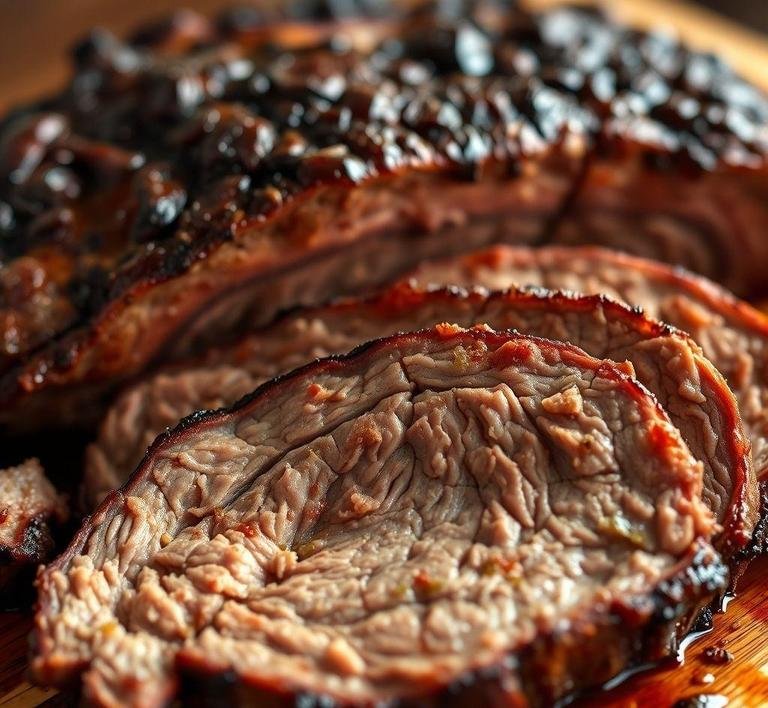Jamie Oliver’s Slow Cooked Brisket is basically a masterclass in turning a tough cut of beef into something melt-in-your-mouth tender. Brisket, by nature, is a chewy and firm cut because it comes from the lower chest of the cow. But Jamie’s magic lies in slow-cooking it low and slow until it’s so soft, it practically falls apart with just a fork. The dish is rich, flavorful and comforting. a perfect centerpiece for family dinners or special occasions.
What makes Jamie’s version stand out is the blend of fresh herbs, spices and his unique twist on the cooking liquid, often including wine or stock. The slow cooking method breaks down the collagen in the meat, creating a succulent texture and deep flavors. The fat in brisket melts slowly, keeping everything juicy. It’s not just food; it’s a cozy experience.
Jamie Oliver Slow Cooked Brisket Recipe
Ingredients Needed
Here’s the lineup for this beauty:
- Brisket (usually about 3-4 pounds): The star of the show.
- Olive oil: To sear the meat and add richness.
- Onions and garlic: Aromatics that build the flavor base.
- Carrots and celery: For sweetness and depth.
- Fresh herbs like rosemary, thyme and bay leaves: These add an earthy, fragrant punch.
- Tomato purée: Gives a slight tang and richness.
- Red wine: For complexity and a touch of acidity.
- Beef stock: To keep everything moist and flavorful.
- Sea salt and black pepper: The basics that bring all flavors together.
- Optional extras could be a splash of Worcestershire sauce or a pinch of chili flakes if you want a little kick.
Every ingredient plays a part. The wine and stock form the braising liquid that infuses the brisket while the veggies and herbs make the whole dish sing.
Equipment Needed
Not much fancy gear here but a few essentials:
- A large, heavy-based casserole or Dutch oven: This is where all the slow cooking magic happens. The heavy base distributes heat evenly.
- Sharp knife: To prep the veggies and trim the brisket if needed.
- Tongs: For searing the meat without losing those precious juices.
- Chopping board: Self-explanatory but essential.
- Oven or slow cooker: Jamie’s recipe usually leans towards oven braising at a low temperature.
- Meat thermometer (optional): Handy to check if your brisket hits that perfect tenderness.
The beauty of this dish is in the slow cooking, so a simple pot and oven do the trick perfectly.
How To Make Jamie Oliver’s Slow Cooked Brisket
Step-by-step, here’s how it unfolds:
- Prep the brisket: Pat it dry, then season generously with salt and pepper. This helps the meat develop a tasty crust.
- Sear the meat: Heat olive oil in your casserole and brown the brisket on all sides. This seals in flavor and gives a nice caramelized surface.
- Sauté your aromatics: Take the brisket out, then toss in onions, garlic, carrots and celery. Cook until soft and fragrant.
- Add tomato purée and herbs: Stir in the tomato purée and herbs, letting everything mingle for a couple of minutes.
- Deglaze with red wine: Pour in the wine and let it bubble up, scraping the bottom to lift all those tasty bits stuck to the pan.
- Return the brisket and add stock: Put the meat back in, pour in enough beef stock to come halfway up the sides.
- Slow cook: Cover the pot with a lid, place it in a low oven (around 140°C/275°F) and let it cook for about 4 to 5 hours. This is the crucial part where the meat becomes tender and so flavorful.
- Check and rest: Once the meat is tender enough to pull apart easily, take it out and let it rest for a bit before slicing.
The result? A luscious, rich brisket with a deeply flavored sauce that’s perfect for soaking up with crusty bread or mashed potatoes.
What I Learnt

Making this brisket taught me a few things:
- Patience is key. The slow cooking transforms the meat in ways quick cooking never could. Rushing it means missing out on that tender texture.
- Searing isn’t just for color. It really adds a depth of flavor that you can taste in every bite.
- Simple ingredients, big impact. Nothing flashy here but the balance of aromatics, herbs and wine brings complexity without overcomplicating.
- Low and slow wins the race. Keeping the temperature low avoids drying out the meat and gives the collagen time to break down.
- Resting matters. Letting the brisket rest helps keep all those juices locked in.
It felt like cooking was as much about respecting the ingredient as it was about the recipe. Slow cooking is a humble, patient craft.
Recipe Tweaks For Jamie Oliver’s Slow Cooked Brisket
Jamie Oliver’s slow cooked brisket recipe is a classic for a reason. it’s tender, flavorful and comforting. But, you know, sometimes a little twist makes it even better. For starters, consider playing with the seasoning. Jamie often goes with a simple rub of salt, pepper and herbs. But what if you add a touch of smoked paprika or chili flakes? It gives a subtle smoky heat that pairs perfectly with the rich beef.
Another fun tweak is the liquid you cook it in. Jamie uses stock and red wine-great combo. But swapping in stout beer or even a splash of bourbon can add unexpected depth. The alcohol cooks off, leaving behind a warm, mellow flavor that seeps into every bite.
And don’t shy away from veggies. Jamie’s recipe includes onions and carrots but throwing in some parsnips, celery root or even whole garlic cloves ups the aroma and complexity. It makes your pot look vibrant and hearty.
Finally, the timing. Slow cooking is forgiving but if you want that fall-apart tenderness with just a bit of bite left, aim for around 8 hours on low heat. If you leave it longer, it becomes melt-in-your-mouth soft-perfect for shredding over mashed potatoes or in sandwiches.
Storage Tips For Leftovers
Leftover brisket is a real treasure but storing it right is key. First, let it cool down a bit before popping it in the fridge. Wrapping it tightly in foil or transferring it to an airtight container helps keep the moisture in and stops it from drying out.
If you want to freeze some, slice it thinly before freezing. That way, you can thaw only what you need. Wrap the slices in parchment paper before putting them in a freezer bag. that stops them from sticking together and makes portioning easier.
When reheating, avoid the microwave if you can. Instead, gently warm the brisket in a pan with a splash of the cooking juices or beef broth. This keeps it juicy and prevents it from getting tough. Low and slow is the mantra here too-blast reheating will dry it out fast.
Also, keep any leftover cooking liquid or sauce. it’s gold for reviving the brisket later. Pour it over when reheating or use it to make a quick gravy.
What To Eat With Jamie Oliver’s Slow Cooked Brisket?
Brisket is rich and hearty, so the sides should either complement or cut through that richness. Classic mash potatoes are an easy winner-creamy and buttery, they soak up the juices like a sponge.
If you want something lighter, roasted or steamed greens like broccoli, kale or green beans add freshness and a bit of crunch. Jamie often pairs brisket with a tangy slaw or pickled veggies which are brilliant for balancing the richness with acidity.
For something more indulgent, try a side of cheesy polenta or garlic bread to soak up every last drop of sauce. If you’re feeling adventurous, add a dollop of horseradish cream or mustard on the side. both add a spicy kick that elevates the brisket experience.
And don’t forget a good, hearty gravy made from the cooking juices. Drizzle it generously. It’s comfort food heaven.
FAQs
How Long Does Jamie Oliver’s Slow-cooked Brisket Take To Cook?
It usually takes around 4-5 hours to cook in the oven on a low heat, depending on the size of the brisket.
What Temperature Should I Cook The Brisket At?
Jamie suggests cooking the brisket at a low temperature, around 160°C (320°F), to ensure it becomes tender.
Can I Prepare Jamie Oliver’s Brisket Recipe In Advance?
Yes! You can prepare the brisket a day ahead, then reheat it gently before serving.


